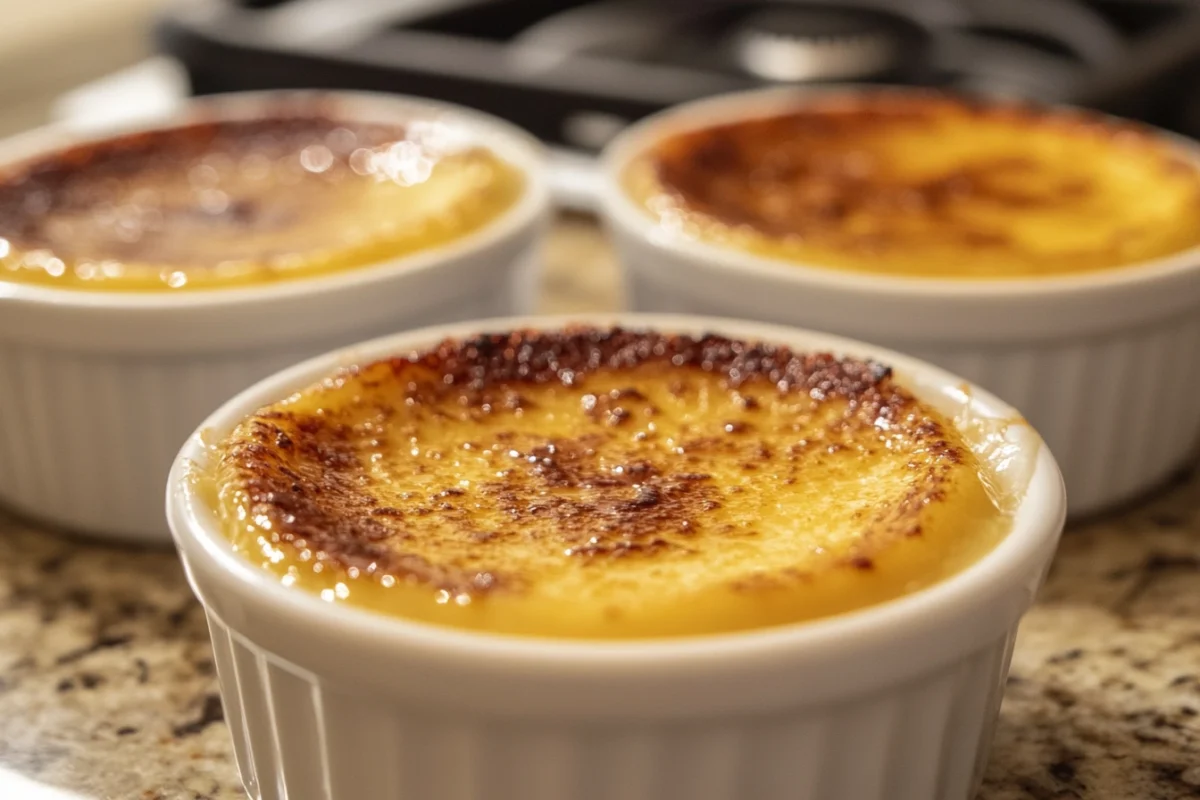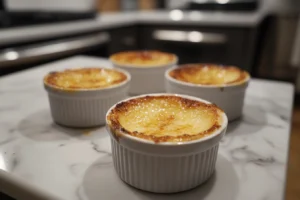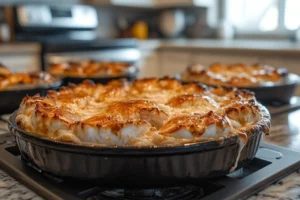What is the secret to crème brûlée? This article delves into the secrets of making the perfect crème brûlée. Learn about the crucial steps and techniques for a truly exquisite dessert.
Unveiling the Mystery: The Essence of Crème Brûlée
Crème brûlée, with its creamy custard and brittle caramelized sugar top, is a beloved dessert. However, achieving the ideal texture and flavor requires precision. Therefore, understanding each step is important. This guide will explore all the key aspects of making crème brûlée. We will cover everything from ingredients to techniques, ensuring your success in creating this elegant treat. Consequently, you will master the crème brûlée making process. Additionally, we will uncover the nuances that elevate a good crème brûlée to a great one.
For inspiration, explore how natural ingredients enhance simple dishes.
The Crucial Components: Key Ingredients for Crème Brûlée
The foundation of a great crème brûlée lies in its simple, yet crucial ingredients. First, heavy cream is essential for the richness and velvety texture. Additionally, use fresh egg yolks because they create the custard base. Sugar, of course, provides sweetness and caramelizes. Finally, a touch of vanilla extract adds warmth. Altogether, these elements are necessary for a harmonious dessert. Moreover, the quality of each ingredient impacts the final result. Therefore, choosing wisely is key.
Heavy Cream: The Backbone of Crème Brûlée
The use of heavy cream is not accidental. It contributes greatly to the luxurious mouthfeel. Moreover, the high fat content ensures a smooth and creamy custard. Therefore, avoid substituting with milk or half-and-half. The fat content is necessary for the proper set. Additionally, the cream must be of high quality. Indeed, using fresh, full-fat cream is non-negotiable for a truly decadent crème brûlée. Consequently, the texture and taste will be greatly enhanced.
Egg Yolks: Binding and Enriching
Egg yolks serve a dual purpose. They not only bind the custard but also add richness. Consequently, use fresh eggs for the best flavor. Furthermore, ensure you only use the yolks. The whites can make the custard too firm. Therefore, carefully separate the yolks from the whites. Moreover, separating them while they are cold can be easier. Thus, this is a helpful tip to keep in mind.
Sugar and Vanilla: Sweetening and Flavoring
The sugar provides sweetness. More importantly, it is what becomes the signature caramelized top. Vanilla extract enhances the flavor profile. Consequently, use a good quality vanilla. Furthermore, vanilla beans can also add depth. Therefore, choose a vanilla that suits your taste. Especially, using pure vanilla extract adds a better taste. Additionally, the type of sugar also matters. Fine granulated sugar works best.
The Art of the Custard: Mastering the Technique
Achieving a smooth, creamy crème brûlée requires more than just good ingredients. The process matters significantly. First, slowly heating the cream with sugar is important. Then, gradually tempering the egg yolks with the warm cream mixture is crucial. This prevents the eggs from curdling. Finally, baking the custard at a low temperature ensures even cooking. Therefore, each step demands careful attention. Consequently, this is how you avoid common mistakes.
Infusion: Enhancing the Base Flavor
Before you start, consider the option to infuse the cream with additional flavors. For example, you can add a cinnamon stick or a few cardamom pods. Then, remove them before adding the egg yolks. Moreover, this technique adds subtle complexity. Furthermore, the warm cream will extract the flavors well. Consequently, you can create a unique taste experience.
Tempering the Egg Yolks: A Vital Step
Tempering the egg yolks prevents them from cooking too quickly. Thus, it keeps the custard smooth. First, slowly add a small amount of the hot cream mixture to the yolks, whisking constantly. Then, keep adding more until the yolks are warm. Afterward, you can add the tempered yolks to the rest of the cream. Therefore, this technique is important. Indeed, this step is fundamental for a silky custard. Additionally, do not skip this step.
Baking: Low and Slow for Perfection
Baking the crème brûlée at a low temperature is key. This ensures the custard cooks gently. In addition, a water bath helps keep the heat even. Consequently, this prevents the custard from curdling. Therefore, avoid overheating. A gentle bake is key. Furthermore, the water bath helps regulate temperature. This is an important detail for perfect results.
The Importance of a Water Bath
The water bath or “bain-marie” isn’t merely a suggestion; it’s a necessity for even cooking. Specifically, the hot water surrounding the ramekins helps to distribute heat evenly. Thus, it protects the delicate custard. Moreover, it prevents the edges from overcooking while the center remains underdone. Therefore, always use a water bath for best results. Consequently, the custard will be uniformly smooth and creamy.
The Alluring Caramel: Creating the Signature Top
The brittle caramelized sugar crust is what defines a crème brûlée. Therefore, this step is crucial for that iconic crack. First, sprinkle a thin layer of sugar evenly on top of the cooled custard. Then, use a kitchen torch to melt and caramelize the sugar. It must be quick. Finally, let the sugar cool to harden. Consequently, you’ll have a perfect, crisp layer. Additionally, this layer contrasts with the creamy custard. Indeed, this contrast is part of what makes this dessert special.
Sugar Application: Thin and Even
Applying the sugar in a thin, even layer is essential. This allows it to caramelize consistently. Therefore, avoid clumping sugar. Also, ensure that it covers the entire custard surface. Consequently, this guarantees even caramelization. Moreover, a fine mesh strainer can help distribute the sugar evenly. Thus, a good tip for a professional looking top.
The Torch Technique: Achieving the Right Color
The goal when using a kitchen torch is to create a deep amber color. Moreover, the sugar should melt and bubble, then harden into a brittle layer. Therefore, keep the torch moving. Furthermore, avoid burning the sugar. Also, practice to find the right distance and flame. Thus, this technique takes practice. Additionally, a low and slow approach with the torch will give a better result.
Broiling: An Alternative Method
If you do not have a torch, you can use your oven’s broiler. However, this requires caution and careful monitoring. Specifically, place the crème brûlée ramekins on a baking sheet and position them under the broiler. Keep a close watch because the sugar can burn quickly under high heat. Moreover, rotate the ramekins as needed for even caramelization. Therefore, broiling is a feasible alternative. But, it’s important to note that a torch gives more precise control.
Troubleshooting Crème Brûlée: Common Issues and Fixes
Even with a good recipe, problems can occur when making crème brûlée. Therefore, it’s helpful to understand common issues. Furthermore, knowing how to fix them ensures success. This section will address common issues. Moreover, you will learn how to fix them. Consequently, you will be able to bake with confidence. Additionally, understanding these problems can also prevent future mistakes.
Custard Not Setting: Diagnosing the Problem
If the custard doesn’t set, several factors could be at play. First, the baking temperature could be too low. Second, the custard may not have cooked long enough. Third, too few egg yolks can lead to a soft custard. Finally, the ratio of cream to eggs is not correct. Therefore, ensure the temperature and ratios are precise. Consequently, it’s key to double-check all measurements.
Caramelizing Difficulties: Addressing the Challenges
Achieving a consistent caramel layer can also be challenging. If the sugar burns too fast, the flame is likely too high. Also, if the sugar isn’t caramelizing, then the flame may be too low. In addition, the sugar layer might be too thick. Furthermore, a non-even layer also causes problems. Therefore, it takes practice to perfect the torching process. Consequently, experience will help refine your technique.
Avoiding Grainy Texture: The Importance of Even Heating
Sometimes, crème brûlée can develop a grainy texture. This often happens when the eggs are exposed to heat that is too high. Specifically, always use a low oven temperature and a water bath to prevent this. Furthermore, don’t overbake the custard. Therefore, proper heat management is crucial. Thus, it ensures a silky, smooth consistency.
Serving and Enjoying Crème Brûlée: Presentation Matters
After perfecting your crème brûlée, how you serve it is also important. Therefore, consider chilling it before serving. This will allow the custard to firm. Additionally, serve it with a spoon for easy breaking of the top. Furthermore, it is good to have some fresh berries. Consequently, you will give a luxurious dining experience. Indeed, presentation enhances the overall enjoyment.
The Art of Presentation: Enhancing the Experience
Presentation can elevate the experience. Serve each crème brûlée in individual ramekins. Then, add a small garnish like mint leaves or berries for added color. Therefore, you can create a delightful look. Furthermore, dust a little powdered sugar on the side for a fancier look. Consequently, the little things make a difference. Additionally, a small edible flower can also add a touch of elegance.
Storage and Shelf Life: Keeping it Fresh
Crème brûlée is best enjoyed fresh. However, if you must store it, keep it in the fridge, and eat it within two days. Moreover, do not caramelize it until you are ready to eat it. Furthermore, moisture can cause the caramel to soften. Therefore, keep it dry and chilled. Consequently, avoid storing it in a humid environment.
Enjoying the Textural Contrast
The true pleasure of crème brûlée comes from the textural contrast. The hard, crisp caramel gives way to a smooth, creamy custard. Therefore, the crack of the spoon through the top is part of the experience. Furthermore, allow your guest to experience this before the first bite. Consequently, this creates anticipation.
Exploring Variations on Crème Brûlée: Beyond the Classic
While the classic crème brûlée is divine, variations can add new dimensions. Think about flavors like chocolate, coffee, or citrus. Moreover, you can also try adding spices such as cinnamon or cardamom. Furthermore, these additions can create delightful twists. Consequently, you will never tire of crème brûlée. Additionally, these variations can be both fun and impressive.
Flavor Infusions: Adding Depth
Infusing flavors into the cream is a great method for changing the taste. For example, steep coffee beans in the cream before making the custard. Also, you can add citrus peels or extracts. Therefore, the possibilities are limitless. Furthermore, you can personalize your crème brûlée. Consequently, your guests will be delighted. Indeed, this is where creativity can shine.
Texture Enhancements: Adding Layers
Variations aren’t limited to flavor. Consider incorporating textural elements. You can add a layer of compote or a crunchy base before pouring the custard. Therefore, this will create interesting mouthfeel. Furthermore, you can play with the sugar texture, making it more crunchy. Consequently, the result can be very creative. Additionally, a layer of finely crushed nuts can also be delicious.
Seasonal Twists on Crème Brûlée
Seasonal fruits and spices can inspire delicious variations. For instance, use pumpkin puree and warm spices in the autumn. Then, try berries and lemon zest in the summer. Consequently, these seasonal touches make crème brûlée even more versatile. Furthermore, the freshest ingredients create the best flavor.
Frequently Asked Questions
Why is my crème brûlée curdled?
The curdling of crème brûlée usually results from excessive heat. Therefore, tempering the egg yolks and using a gentle baking method are necessary. Furthermore, avoid a high oven temperature and direct heat. Consequently, you will achieve a smooth consistency. Additionally, patience is key.
How do I prevent the caramelized sugar from getting soggy?
To prevent sogginess, caramelize the sugar just before serving. Also, make sure the custard is cold when you add the sugar. Therefore, the moisture from the custard won’t soften the sugar. Furthermore, the sugar layer must be thin. Consequently, your topping will stay crispy. Additionally, avoid any moisture or steam.
Can I make crème brûlée without a kitchen torch?
While a torch provides the best results, you can caramelize the sugar using a broiler. Therefore, ensure the custard is cold and place it under a hot broiler for a few minutes. However, watch it carefully to prevent burning. Furthermore, this method may not give the same results. Consequently, a torch is the preferred option. Additionally, a broiler is much less precise.
How long does crème brûlée last in the refrigerator?
Properly stored, crème brûlée will last up to 2 days in the refrigerator. Therefore, store it in an airtight container and avoid caramelizing the top until just before serving. Furthermore, moisture may affect its texture. Consequently, enjoy it within the recommended time. Moreover, be mindful of potential condensation.
Crème Brûlée: A Dessert Worth the Effort
In conclusion, making crème brûlée might seem complex. However, with the correct method, you can master it. The key is in the details. The ingredients, the techniques, and the final caramelization are important. Therefore, take your time and focus on each step. Consequently, you will find it’s easier than you think. Furthermore, this elegant dessert is worth every minute. Moreover, the joy of creating this classic dessert is very rewarding.



